
11 Storytelling Formulas to Supercharge Your Social Media Marketing
Product Marketing @ Buffer
Legendary marketer, Seth Godin, describes marketing as “the art of telling a story that resonates with your audience and then spreads.”
If you look at some of the biggest brands around, you might notice that they are often amazing storytellers.
- Apple tells stories of people challenging the norms
- Nike tells stories of people doing the impossible
- Airbnb tells stories of travelers living in homes around the world and belonging anywhere.
But how do you tell compelling stories? How do you tell stories that your audience wants to hear? And how do you tell your brand story?
While researching on the topic of storytelling, I discovered several tested-and-proven storytelling formulas — formulas used by companies like Pixar, Apple, and more.
These formulas can be applied to your company’s overall marketing, content you produce, social media updates, copy on your website, and more.
Ready to jump in?

11 storytelling formulas to supercharge your social media marketing
1. Three-Act Structure
Setup — Set the scene and introduce the character(s)
Confrontation or “Rising action” — Present a problem and build up the tension
Resolution — Resolve the problem
The three-act structure is one of the oldest and most straightforward storytelling formulas. You might recognize this structure in many of the stories you come across.
In the first act, set the stage and introduce the character(s) of the story. In the second act, present a problem faced by the character(s) and build up the tension. In the third act, deliver the climax of the story by resolving the problem (with your product or service).
Example:

2. Freytag’s Pyramid: Five-Act Structure
Exposition — Introduce important background information
Rising action — Tell a series of events to build up to the climax
Climax — Turn the story around (usually the most exciting part of the story)
Falling action — Continue the action from the climax
Dénouement — Ending the story with a resolution
The Freytag’s Pyramid is created by Gustav Freytag when he analyzed the stories by Shakespeare and ancient Greek storytellers.
It is a more elaborate form of the three-act structure, which puts emphasis on the climax and the falling action of the story as much as the other parts of the story.
Example:

3. Before – After – Bridge
Before — Describe the world with Problem A.
After — Imagine what it’d be like having Problem A solved.
Bridge — Here’s how to get there.
This is our favorite storytelling and copywriting formula. We have been using it for our blog post introductions but it can be applied to social media updates, email campaigns, and other marketing messages.
Set the stage of a problem that your target audience is likely to experience — ideally a problem that your company solves. Describe a world where that problem didn’t exist. Explain how to get there or present the solution (i.e. your product or service).
Example:
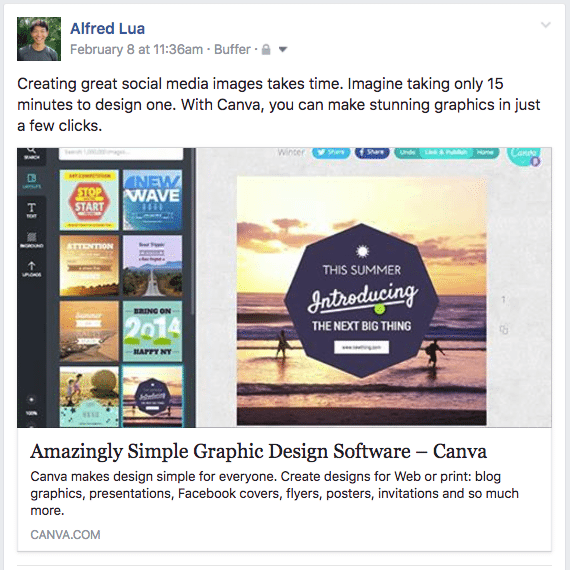
4. Problem – Agitate – Solve
Problem — Present a problem
Agitate — Agitate the problem
Solve — Solve the problem
This is one of the most popular copywriting formulas, which is great for storytelling, too.
The structure is quite similar to the Before-After-Bridge formula. First, you present a problem. Second, instead of presenting the “After”, you intensify the problem with emotional language. Finally, you solve the problem by offering your product or services.
Example:
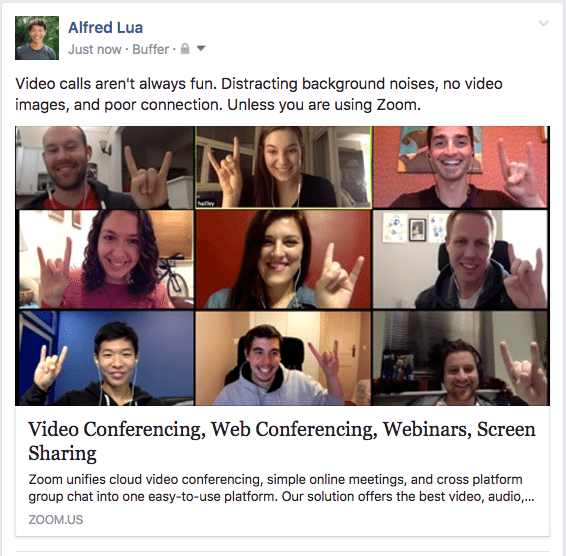
5. Simon Sinek’s Golden Circle
Why — Why the company exists
How — How the company fulfills its Why
What — What the company does to fulfill its Why
Simon Sinek’s TED talk, How great leaders inspire action, is one of the most viewed TED talks ever, with more than 30 million views so far. He explained that great companies like Apple inspire people and succeed because they use the Golden Circle formula.
Always start with your Why — Why are you in this business? What motivates you? Then, explain how your company will achieve your Why. Finally, describe in tangible terms what your company does to bring your Why to life (i.e. your products and services).
Example:
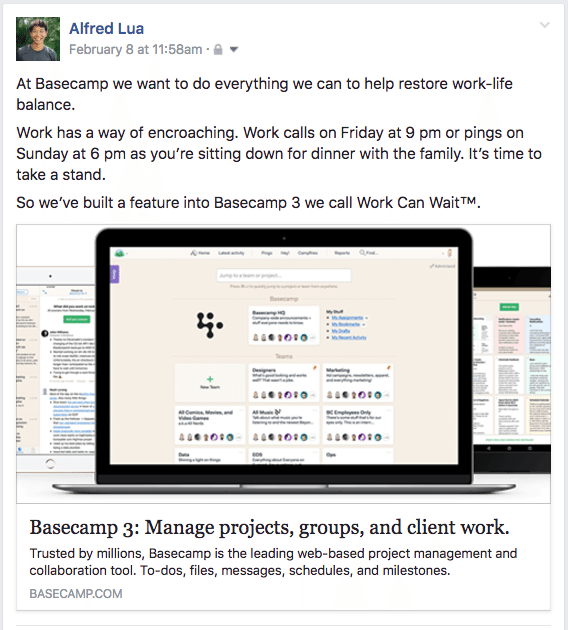
6. Dale Carnegie’s Magic Formula
Incident — Share a relevant, personal experience
Action — Describe the specific action taken to solve or prevent a problem
Benefit — State the benefits of the action
How to Win Friends and Influence People is one of our favorite books at Buffer. After studying many great leaders, the author, Dale Carnegie, developed this simple three-step storytelling formula that can help you persuade your audience.
Open your story with a personal experience relevant to your point to grab your audience’s attention. Describe the actions you took chronologically, showing that a change was needed. Wrap up the story by connecting the change to its benefits. (This could be a customer’s testimonial, too!)
Example:
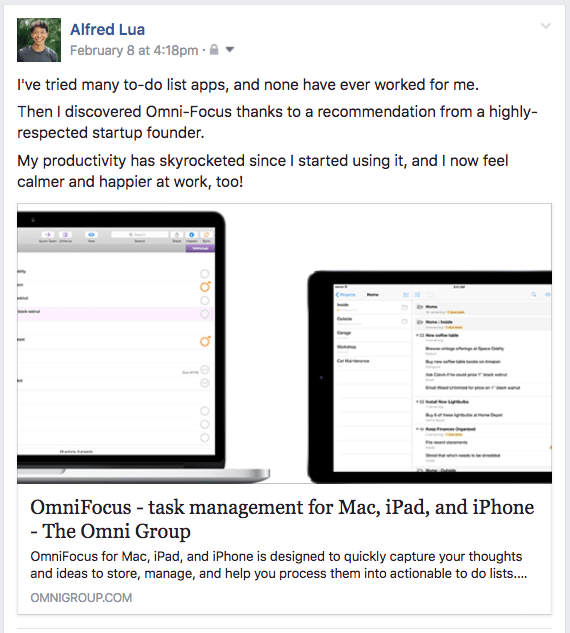
7. Dave Lieber’s V Formula
Introduce the character
Bring the story to its lowest point
Turn it around and finish with a happy ending
Dave Lieber is a keynote speaker and the Dallas Morning News Watchdog columnist, who has been telling stories for almost 40 years. In his TED talk, The power of storytelling to change the world, he shared the story formula he has been using for his stories.
Once you introduce the character of the story, describe how things went awful for her, using emotions to draw your audience into your story. At the lowest point of the story, turn things around, describe how things improved, and end the story on a high note.
Example:
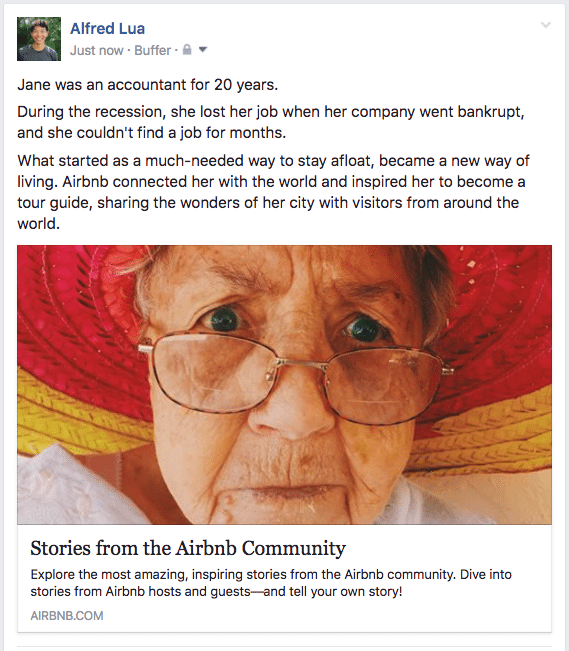
(Inspired by a true Airbnb story)
8. Star – Chain – Hook
Star — An attention-getting, positive opening
Chain — A series of convincing facts, benefits, and reasons
Hook — A powerful call-to-action
This formula is developed by, I believe, a Chicago consultant, Dr. Frank W. Dignan.
The star grabs your audience’s attention. The chain turns your audience’s attention into a desire. The hook gives them something actionable to fulfill their desire.
Example:

9. Pixar’s award-winning formula
Once upon a time there was ___. Every day, ___. One day ___. Because of that, ___. Because of that, ___. Until finally ___.
Former Pixar storyboard artist Emma Coats shared 22 narrative rules she had learned during her time at Pixar. Among the 22 rules was this simple storytelling formula that has helped Pixar win countless awards, including 13 Academy Awards, 9 Golden Globes, and 11 Grammys.
You don’t have to follow the wording exactly. The idea, as I see it, is to introduce a character or a group of character, describe their usual routine, present a twist that disrupts their daily lives, explain how they overcome it, and celebrate!
Update: This formula is known as “The Story Spine” and was created by Kenn Adams, a professional playwright and improviser. The original formula includes an important last line, “And, ever since then___”. (Thanks, Kay Ross, for pointing this out to us.)
Example:

10. The Hero’s Journey
Departure — A hero receives a call to go on an adventure, receives advice from a mentor, and heads out on her journey.
Initiation — The hero meets a series of challenges but eventually completes the mission.
Return — The hero returns and helps others with her new found power or treasure.
The original hero’s journey is made up of 17 stages which are organized into the three acts described above. This formula is used by many of the greatest storytellers including George Lucas for his Star Wars films!
The hero of your story would often be your customers. They experience some tricky situations in their lives or work but eventually solve the problems with your product or service, improving their lives or bringing results to their company.
Example:
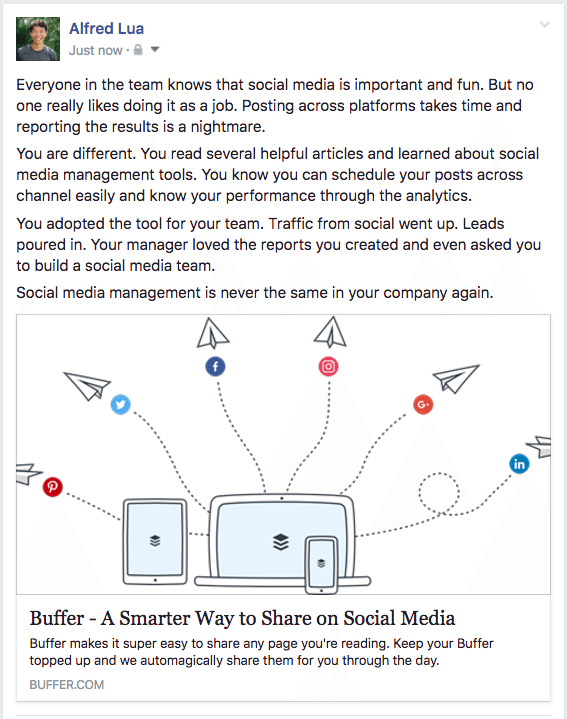
11. Nancy Duarte’s secret structure of great talks
What is — The status quo
What could be — The future that could be possible
Go back and forth between the two and end off with a …
New bliss — The wonderful future with your idea/product/service adopted
Nancy Duarte’s TED talk, The secret structure of great talks, has been viewed more than a million times. In her talk, she revealed the secret formula that Steve Jobs and Martin Luther King might have used for their famous speeches.
Start by describing the current situation and then contrast that with a future that’s way better. Make the present unappealing and the future attractive. Go back to the present and then point to the future again. End the story with the new state where your product or service is adopted.
Example:
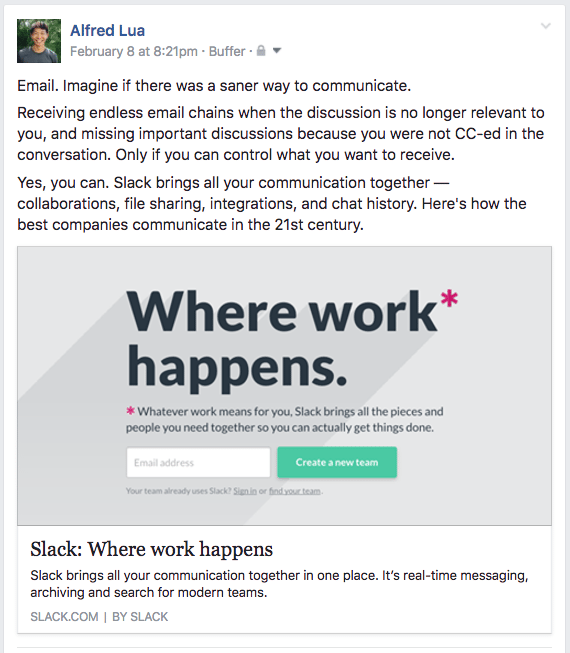
5 storytelling tips from amazing storytellers
Armed with these 11 storytelling formulas, you are ready to tell your brand stories. To help you tell even better stories, I curated advice from several amazing storytellers. Here’re five tips from them:
1. Don’t complicate things
(by Lindsay Smith via Buffer)
Lindsay Smith is a producer at National Geographic Travel, who was awesome to join us for a podcast episode recently. National Geographic Travel has more than 25 million fans across their social media accounts.
One thing that’s very important for social media and storytelling in general, is to not complicate things unnecessarily. While we want to be very thoughtful about the stories and posts that we’re sharing, we don’t want to muddy that story up with irrelevant information. What’s important is that you keep it simple.
(Emphasis mine)
2. The 3 things to ask
(by Lindsay Smith via Buffer)
Here’s another advice from Lindsay that I love:
To tell a great story you must ask three things:
- Is this story going to be interesting? (Gut Check)
- What is the best way to tell this story? (Format)
- How do people want to see this story and how are they going to consume it? (Visual Element)
(Emphasis mine)
In terms of storytelling format, here’re 20 creative ways to use social media for storytelling for your inspiration.
3. Create detailed imagery to craft the setting you want
(by Gregory Ciotti via Sparring Mind)
Gregory Ciotti is one of my favorite marketers. When he was at Help Scout, he helped grow the company blog to almost 4 million unique visitors per year.
In his article, The Psychology of Storytelling, he shared the importance of storytelling, ways to create better stories, and characteristics of highly persuasive stories. Here’s my favorite advice from his article:
Creating detailed imagery helps craft the setting YOU want
Want to get people swept up in your stories?
Tell them what they are getting swept up in to, and they will respond.
Could any of us relate to the heroic deeds in tales like those of the Lord of the Rings without Tolkien’s exquisitely detailed descriptions of the dangers of Mordor or the perils faced by Frodo and Sam?
The imagery paints the picture of any good story, we could say that [Spoilers if you haven’t read/seen Lord of the Rings] “Frodo and Sam fight a giant spider,” but Tolkien spends an entire chapter on the ordeal, taking the time to help the reader visualize the ferocious nature of the enemy and the bravery of our heroes who persevere despite their many weaknesses (doubt, fear, dismay, etc.)
Implementing the “real” into a fantastic setting often helps create a better connection with the reader.
I don’t know the feeling of encountering a spider the size of a house, but I do know what terror feels like, and I also know how hard it can be to persevere in the face of immense doubt of your abilities.
These “all-too-real” elements of a fantastical story make it easier to relate to.
(Emphasis mine)
The awesome thing about storytelling on social media is that you can use multimedia such as images and videos to complement your words. Instead of asking your audience to imagine, you can show it to them.
4. Parachute in, don’t preamble
(by J.D. Schramm via Harvard Business Review)
J.D. Schramm is a lecturer on Organizational Behavior at Stanford Graduate School of Business, where he teaches effective communications.
In his Harvard Business Review article, A Refresher on Storytelling 101, he shared seven advice on successful storytelling, and this is my favorite:
Parachute in, don’t preamble. The best storytellers draw us immediately into the action. They capture our attention and set the tone for a unique audience experience. Avoid opening with “I’d like to tell you a story about a time when I learned…” Instead, drop us into the action and draw the lesson out later.
As people on social media tend to have short attention span, your stories have to grab their attention immediately or they might just scroll past your post.
5. Get Personal
(by Kathy Klotz-Guest via Convince & Convert)
Kathy Klotz-Guest is the founder of Keeping It Human, which helps companies create compelling stories.
I read her article, 7 Ways to Make Your Business Storytelling Awesome, and this point stood out for me:
3. Get Personal
…
Great, emotional brand storytelling must be told through the lens of a person: a specific customer, a passionate employee, or a dedicated partner. Every great company story must be anchored in a human story and told through a personal human lens. Anchor your stories through real people, and you’ll see a big difference in your storytelling.
(Emphasis mine)
This reminds me that the stories we tell should seldom have our company as the main character or the hero. The hero of our stories should be our customers and community. The best example is the stories told by Airbnb, which are often about their hosts or guests.
What’s your favorite way of telling stories?
Whenever I write, I often find it easier when I have a structure in mind already. I hope these storytelling formulas help you in the same way when you craft your amazing social media stories.
I’m sure there are many other ways of telling stories. Would you be up for sharing your favorite way? Thanks!
—
Some of the icons in the header image are from Iconfinder.
Try Buffer for free
140,000+ small businesses like yours use Buffer to build their brand on social media every month
Get started nowRelated Articles
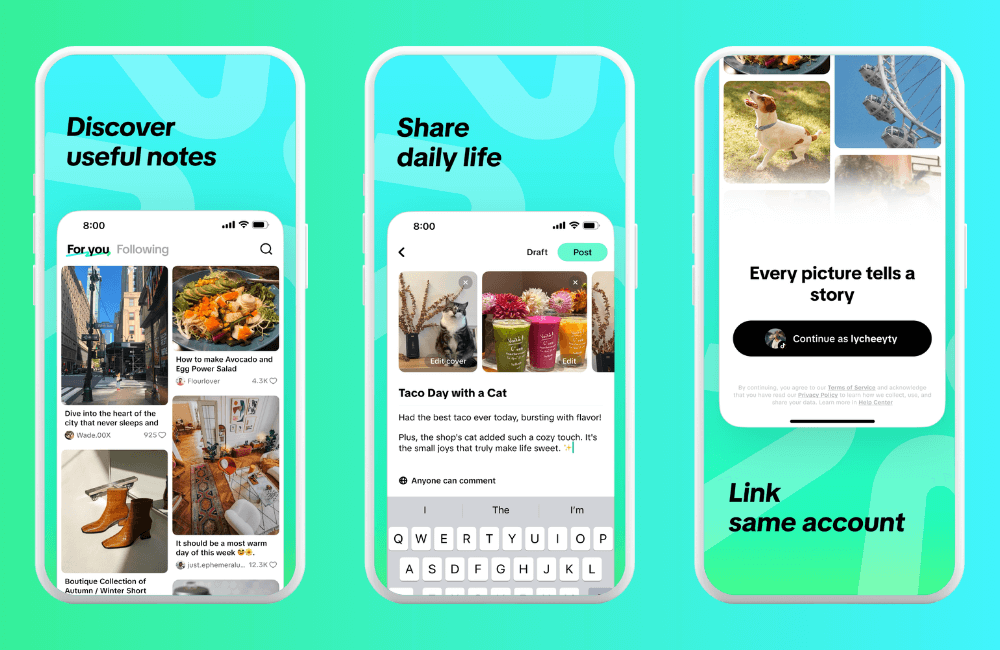
TikTok Notes is coming — and the new text and photo-sharing app is not just an Instagram clone. Here's everything we know about the platform so far.

How to source the best audio clips for your TikToks while they’re still popular, plus examples of TikTok sounds with staying power.

In this article, we've curated the top five graphic design trends for social media branding in 2024.